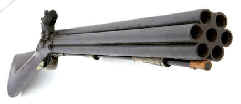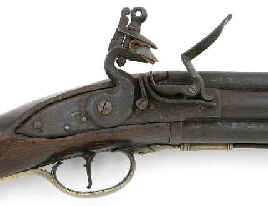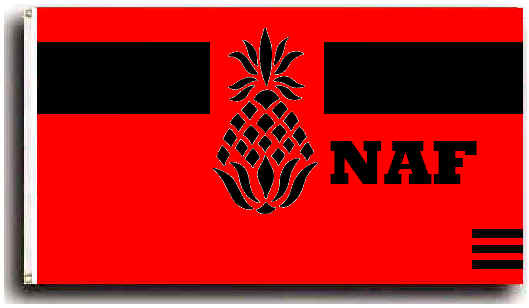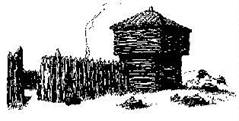This gun has always been
an interesting design, just its appearance would make ones blood
run cold.
___________________________
The Nock gun was a seven-barreled smoothbore flintlock
firearm used briefly by the Royal Navy [1]
during the Napoleonic Wars. A volley gun originally designed for
ship-to-ship fighting, its use was limited and eventually
discontinued because of inherent flaws in using it.
- [1]From the beginning of the 18th century until well into
the 20th century it was the most powerful navy in the world,
playing a key part in establishing the British Empire as the
dominant world power from 1815 until the early 1940s.

History
and design
The weapon was invented by British engineer James Wilson in
1779, and named for Nock, the London-based armaments
manufacturer contracted to build the gun. It was intended to be
fired from the rigging of Royal Navy warships onto the deck in
the event that the ship was boarded by enemy sailors.
Theoretically, the simultaneous discharge of seven barrels would
have devastating effect on the tightly packed groups of enemy
sailors.
|
The
Nock gun was made popular due to its appearance in the
movie "The Alamo" and also seen in
Bernard Cornwells's "Sharpe Series", in
which the character Patrick Harper (a strong, burly man)
wields an ex-Navy Nock gun.

|
| Nock
Gun |
| Type |
Volley gun |
| Place of origin |
United Kingdom |
| Service
history |
| In service |
Royal Navy
1790s-1804 |
| Used by |
United Kingdom |
| Wars |
Napoleonic Wars
|
| Production
history |
| Designed |
1779 |
| Specifications |
| Barrel length |
20 inches (510 mm) |
|
| Chamber length |
.52 inches (13.2 mm) |
| Ignition |
Flintlock |
| Rate of fire |
Seven rounds per discharge, reloading rate
variable |
| Muzzle velocity |
Variable |
| Effective range |
Variable |
| Feed system |
Muzzle loaded |
|
The volley gun consisted of seven barrels welded together,
with small vents drilled through from the central barrel to the
other six barrels clustered around it. The central barrel
screwed on to a hollow spigot which formed the chamber and was
connected to the vent.
The gun operated using a standard flintlock mechanism, with
the priming gunpowder igniting the central charge via a small
vent. When the flash reached the central chamber, all seven
charges ignited at once, firing more or less simultaneously.

The first models featured rifled barrels, but this made
loading a long and cumbersome process, resulting in all
following models being manufactured with smoothbore barrels.
Deployment
and Use
During the early stages of the Napoleonic Wars, 635 Nock guns
were purchased by the Royal Navy. However, attempts to use the
gun during combat quickly revealed design flaws. The recoil
caused by all seven barrels firing at once was more powerful
than had been thought, and frequently broke the shoulder of
whoever was firing the gun, and in any case made the gun
extremely difficult to aim and control. Furthermore, officers
were reluctant to issue the guns during battle out of fear that
the flying sparks would set fire to the surrounding rigging and
sails.
A smaller, lighter version was produced, which shortened the
gun's range, but the recoil was still too powerful for sailors
to feel comfortable using it. The few models purchased by the
Royal Navy were removed from service in 1804.
An example is available for viewing in the weapons gallery at
York Castle Museum and The Charleston Museum (SC).
WikipediaŽ Free Encyclopedia
___________________________

If you
were on the wrong end
of this weapon wouldn't you think twice about boarding a Royal Navy
ship! I would think many changed their thoughts of
engaging the British Royal Navy in ship-to-ship fighting.
Later
Buck Conner


___________________________